This post may contain affiliate links. Please read our disclosure policy.
One of the greatest of all Lebanese pastries is knafeh jibneh with orange blossom syrup. Knafeh is shredded phyllo dough (find it in Middle Eastern markets) which is filled here with a wonderful cheese blend for a melty, salty-sweet (mostly sweet . . . ) pastry. The Lebanese eat knafeh traditionally for breakfast in a pocket of sesame ka’ik bread. Hearty!
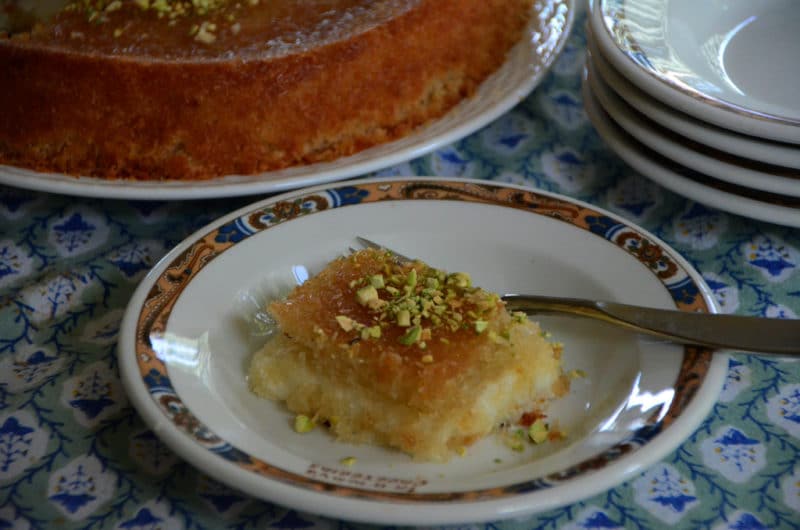
Though Lebanese knafeh is iconic, I enjoyed my first taste of this special pastry in Lebanon at the famous Hallab bakery. From that moment on I pursued developing the best Lebanese knafeh recipe for homemade knafeh, which makes an impressive dessert (or if in Lebanon, breakfast!).
What is knafeh?
Knafeh is a traditional dessert enjoyed in Lebanon and throughout the Middle East. It’s composition is layers of crisp kataifi dough (shredded phyllo) filled with cheese. While this is a kind of cheesecake, the flavor is not like cheesecake made with cream cheese. The cheese in knafeh may vary greatly depending on the style of knafeh, from a melty ackawi cheese much like mozzarella to a soft style cheese such as ricotta.
Slices of knafeh receive a drizzle of attar, the orange blossom simple syrup that is an important component in many Lebanese pastries such as Lebanese baklawa.
The pastry is often served tucked into a split bread that is coated with sesame seeds, a version of ka’ik (kaak), that allows the eater to take the whole bundle on the go!
Ingredients
For the Orange Blossom Syrup
1 1/2 cups granulated sugar
3/4 cups water
Lemon juice. A squeeze of citrus helps prevent crystallization and adds a bright flavor note.
Orange blossom water. The syrup in Middle Eastern cuisine may vary in flavoring: orange blossom water, rose water, a combination of the two, or none at all.
For the Pastry
1/2 package shredded phyllo knafeh dough (kataifi), or 3 cups
1 cup panko or plain dry breadcrumbs
1 cup (2 sticks) unsalted butter, melted
1/2 cup orange blossom syrup, plus more for serving
2 cups shredded mozzarella or ackawi cheese. Traditional recipes often call for soaking the ackawi cheese to remove the salt. I love the salty flavor of the cheese with the sweetness of the other ingredients!
2 cups whole milk
1/3 cup farina (cream of wheat)
1/4 cup crushed pistachios, for serving
How to make knafeh
For the syrup:
Step 1. In a small heavy saucepan, combine sugar, water and lemon juice and bring to a boil over medium high heat. Reduce heat to low and simmer for 5 minutes. Add the orange blossom water, pour into a heatproof container, cool to room temperature and refrigerate to chill.
For the pastry:
Preheat the oven to 400°F with a rack in the middle position.
Shred the kataifi dough
In the food processor, pulse the shredded phyllo dough for about a minute to make it into a fine meal. Place the phyllo in a medium bowl with the breadcrumbs. Add the melted butter and ½ cup of orange blossom syrup and stir until the phyllo is completely coated.
Soak and shred the cheese
If the cheese is too salty, slice and soak it in cold water for about 30 minutes. Change the water every 10 minutes or so. Either with a large, sharp knife or in the food processor, chop the cheese to a fine dice (in the food processor, pulse until the cheese looks like coarse meal). Place the cheese in a medium bowl.
Build the layers
In a 10-inch pie plate or cake pan (or a similar sized sheet pan), add the buttery dough mixture. Compress it very well by pushing it into the bottom of the pan firmly, first with your hands, then pressing with the flat bottom of a cup, or something similar.
In a medium heavy saucepan, heat the milk over medium-high heat until it is hot, but not boiling. Add the farina and cook for 2 minutes, stirring constantly, until the mixture is slightly thickened. Pour the farina over the cheese and stir to combine.
Pour the cheese mixture over the compressed knafeh dough in the prepared pan, and smooth the top. Place in the oven and bake for 30-40 minutes, or until the knafeh is deep golden brown. Remove from the oven and cool for 15 minutes.
Flip the baked knafeh
Turn the knafeh out onto a platter by placing the platter upside down over the cake pan. Hold both the plate and the sides of the baking pan, and flip to invert the cake out onto the plate.
Drizzle with ¼ cup of orange blossom syrup. Garnish with pistachio nuts. Serve immediately or set aside and reheat before serving. Cut into squares or slices and serve the knafeh warm, with more orange blossom syrup poured over each piece.
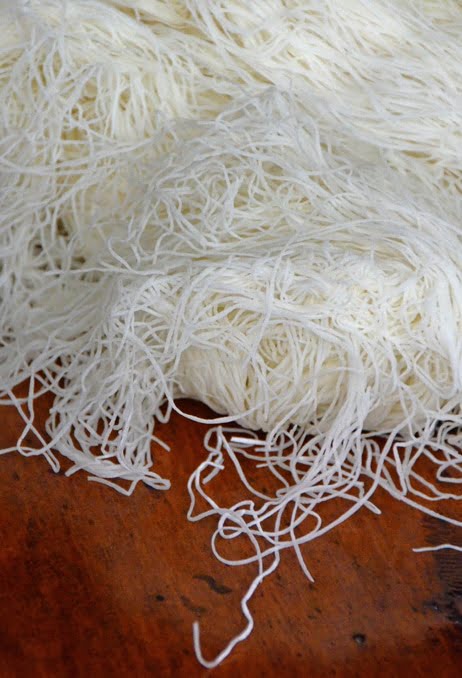
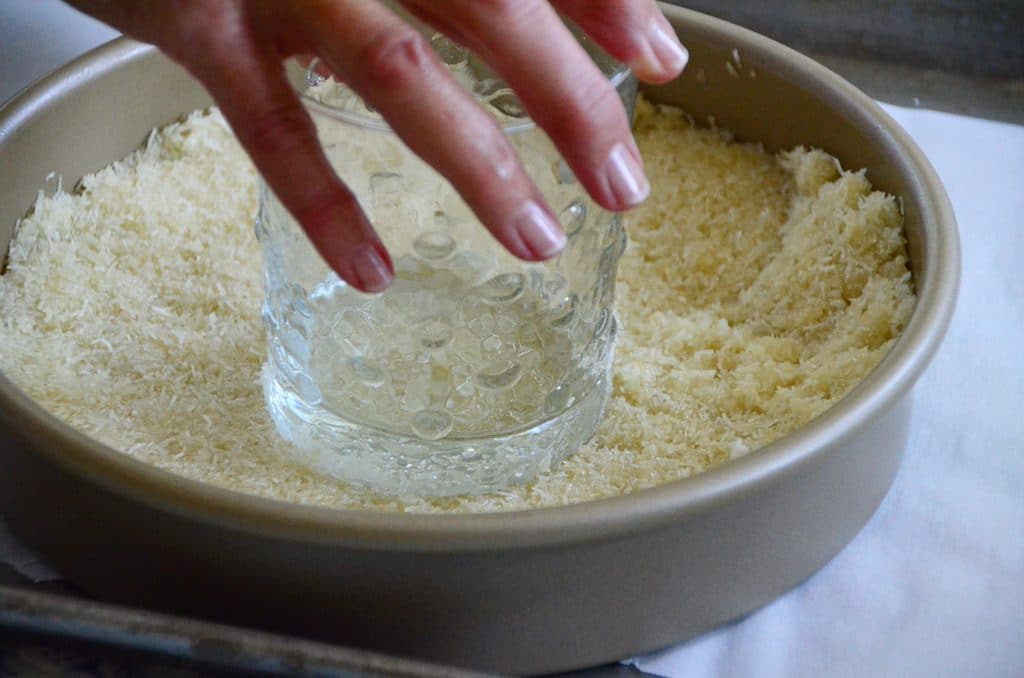
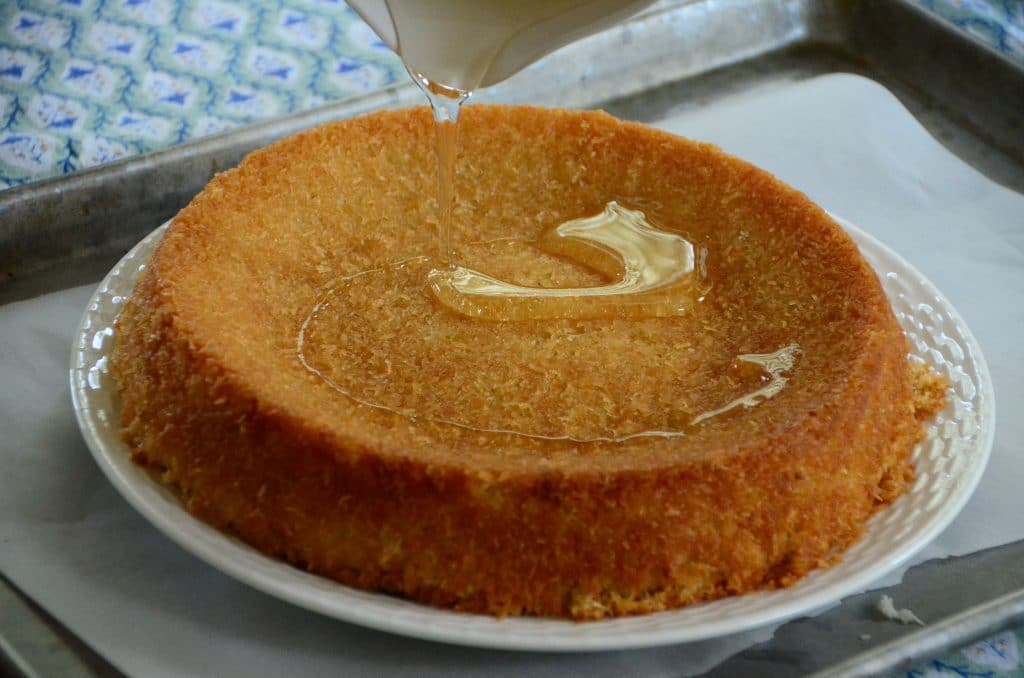
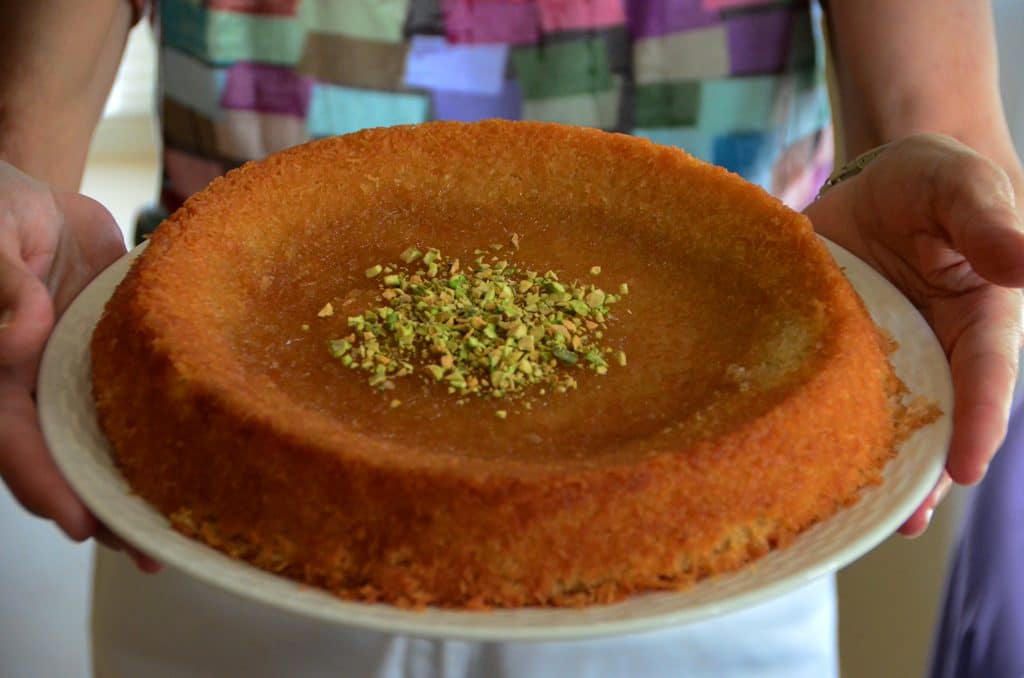
Tips
- Color the knafeh. Sometimes the kataifi pastry has a bright orange hue from food coloring. Find this dry food coloring online or in a Middle Eastern store as “Kunafeh” and whisk a pinch in the butter before combining it with the kataifi.
- Ackawi cheese is the traditional cheese for knafeh. An excellent substitute is a block of mozzarella cheese (not fresh mozzarella, which contains too much moisture for this knafeh recipe).
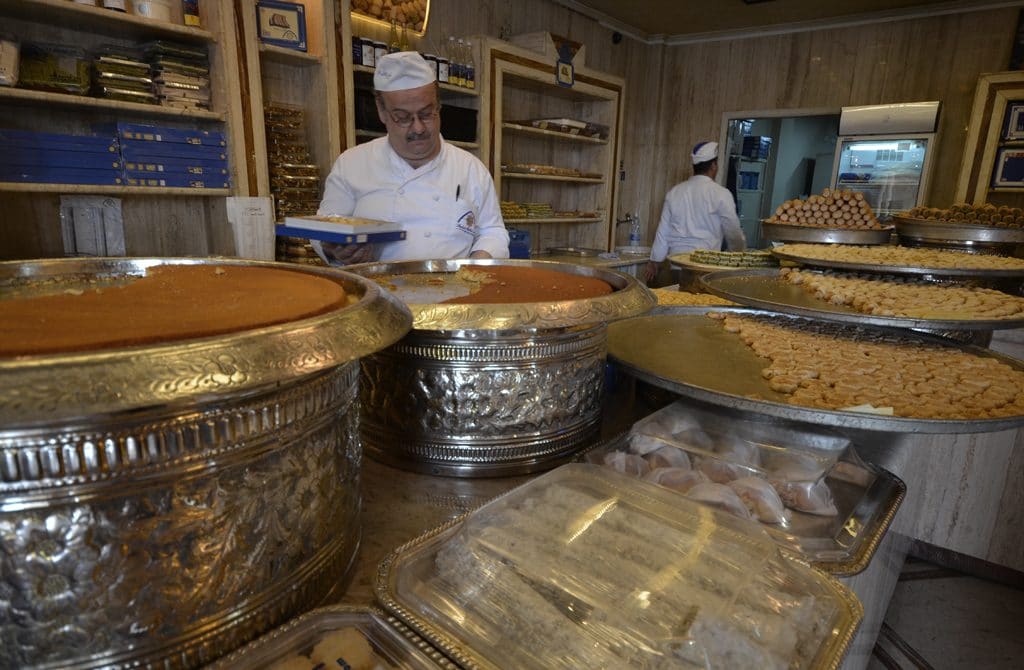
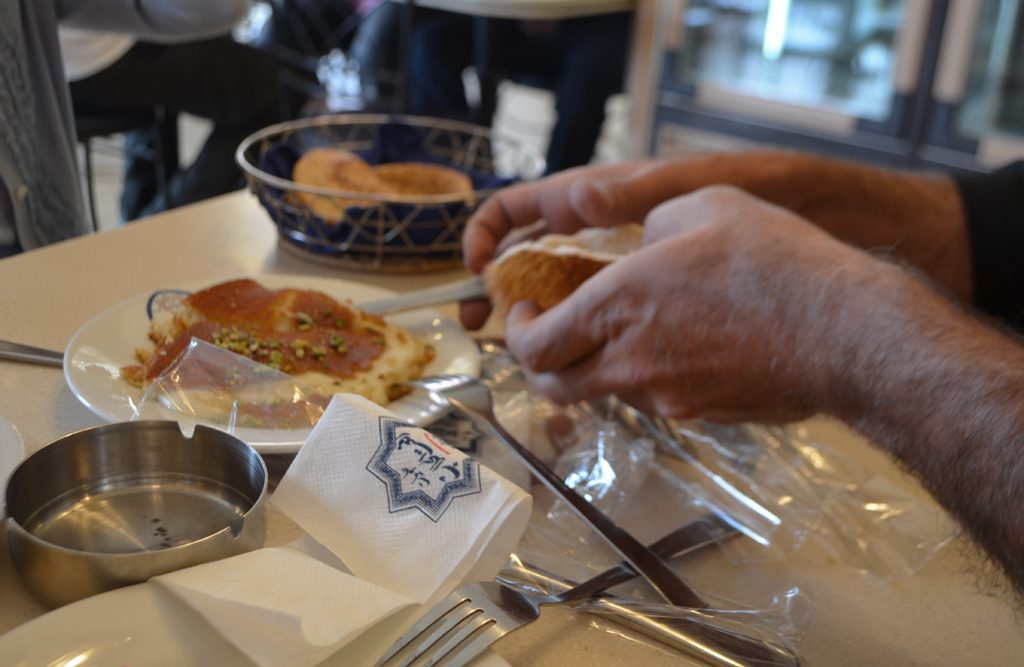
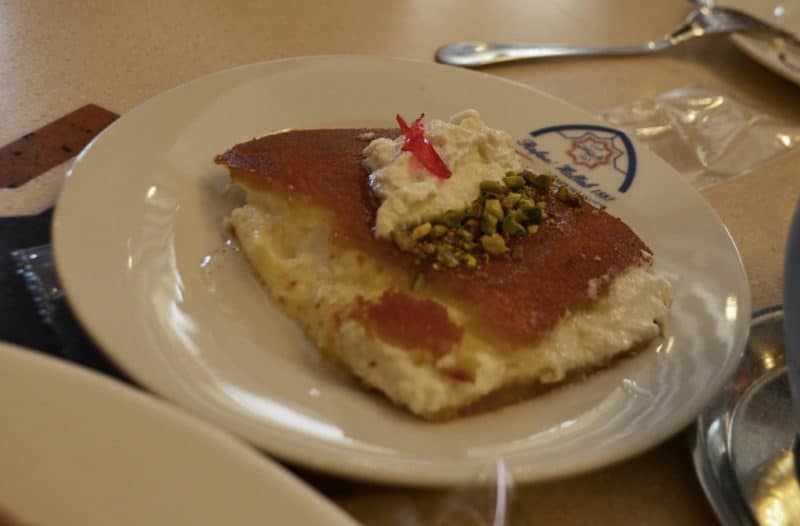
Storage
Store the knafeh with a loose covering of plastic wrap, in the refrigerator. Reheat the knafeh in a warm (200°F) oven for about 10 minutes, or until warm. Serve with a fresh drizzle of the syrup.
What is the difference between baklava and knafeh?
Two very different pastries, both special to Middle Eastern cuisine and favorites in Lebanese cuisine. The similarities are that both pastries include fragrant syrup and types of phyllo dough.
Knafeh employs shredded phyllo, kataifi dough, as layers with a filling of melty cheese. Syrup is drizzled over slices of the pastry when it is served.
Baklava calls for sheets of thin phyllo dough coated with clarified butter. There are many shapes and sizes of baklava, perhaps the most well-known being baklava diamonds of layers of buttered phyllo filled with nuts (walnuts, crushed pistachios, cashews, or almonds) and finished with fragrant attar syrup.
What does knafeh taste like?
In a word: Heavenly! The shredded phyllo layers are toasty, buttery in flavor. The cheese layer is mild with a chewy cheese texture. Overall the flavor and texture combination is enhanced with simple syrup, which when made with aromatic flower waters, imparts another layer of gorgeous sweet-floral flavor. Knafeh tucked into a pocket of sesame kaak bread is yet another fabulous flavor and textural experience, with the chewy, sesame bread elevating the sweet cheese knafeh even further!
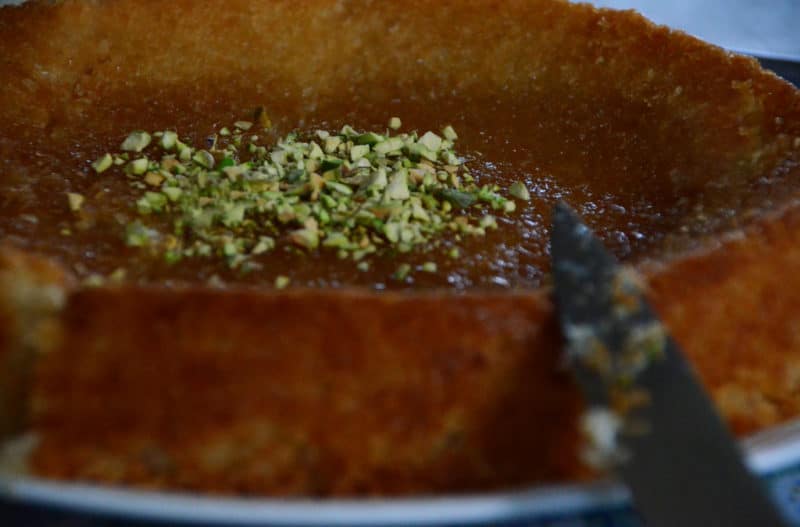
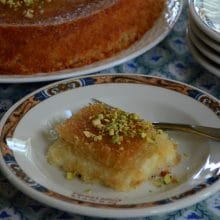
Lebanese Knafeh Jibneh with Orange Blossom Syrup
Ingredients
For the Orange Blossom Syrup
- 1 1/2 cups sugar
- 3/4 cups water
- 1 tablespoon lemon juice
- 2 teaspoons orange blossom water
For the Pastry
- 1/2 package shredded phyllo knafeh dough (kataifi), or 3 cups
- 1 cup panko or plain dry breadcrumbs
- 1 cup (2 sticks) unsalted butter, melted
- 1/2 cup orange blossom syrup, plus more for serving
- 2 cups shredded mozzarella or ackawi cheese
- 2 cups whole milk
- 1/3 cup farina (cream of wheat)
- 1/4 cup pistachios, chopped, for serving
Instructions
- To make the orange blossom syrup, in a small heavy saucepan, combine sugar, water and lemon juice and bring to a boil over medium high heat. Reduce heat to low and simmer for 5 minutes. Add the orange blossom water, pour into a heatproof container, cool to room temperature and refrigerate to chill.
- Preheat the oven to 400 degrees with a rack in the middle position.
- In the food processor, pulse the shredded phyllo dough for about a minute to make it into a fine meal. Place the phyllo in a medium bowl with the breadcrumbs. Add the melted butter and ½ cup of orange blossom syrup and stir until the phyllo is completely coated.
- In a 10-inch pie plate or cake pan (or a similar sized sheet pan), add the buttery dough mixture. Compress it very well by pushing it into the bottom of the pan firmly, first with your hands, then pressing with the flat bottom of a cup, or something similar.
- If the cheese is too salty, slice and soak it in cold water until some of the salt is pulled out. Change the water every 10 minutes or so. Either with a large, sharp knife or in the food processor, chop the cheese to a fine dice (in the processor, pulse until the cheese looks like coarse meal). Place the cheese in a medium bowl.
- In a medium heavy saucepan, heat the milk over medium-high heat until it is hot, but not boiling. Add the farina and cook for 2 minutes, stirring constantly, until the mixture is slightly thickened. Pour the farina over the cheese and stir to combine.
- Pour the cheese mixture over the knafeh dough in the prepared pan, and smooth the top. Place in the oven and bake for 30-40 minutes, or until the knafeh is deep golden brown. Remove from the oven and cool for 15 minutes.
- Turn the knafeh out onto a platter and drizzle with ¼ cup of orange blossom syrup. Garnish with pistachio nuts. Serve immediately or set aside and reheat before serving. Cut into squares or slices and serve the knafeh warm, with more orange blossom syrup poured over each piece.
Nutrition information is automatically calculated, so should only be used as an approximation.
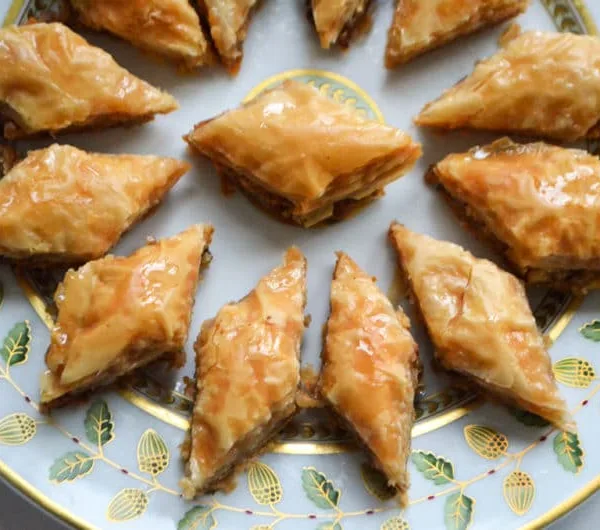
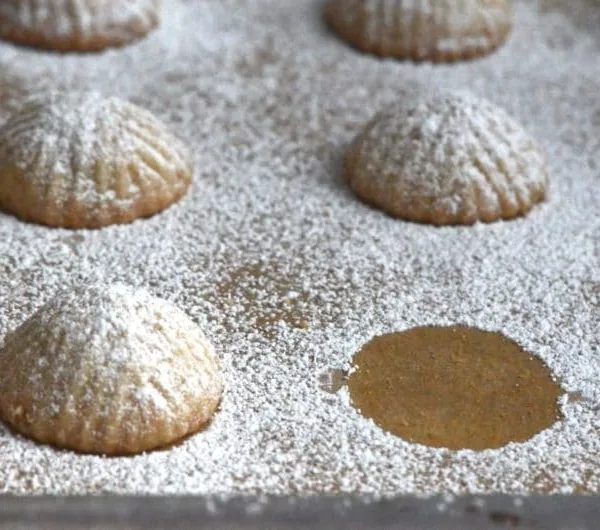
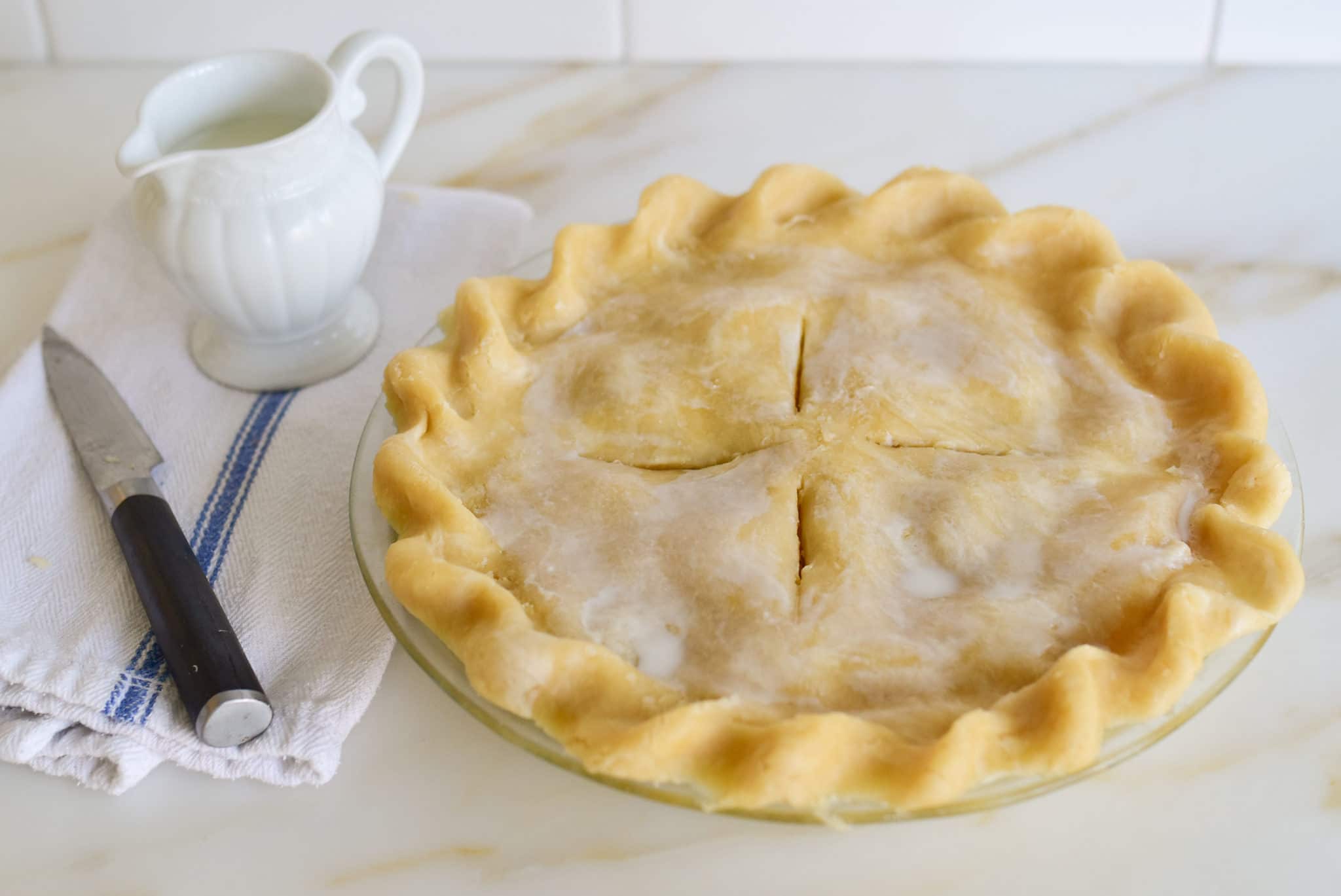
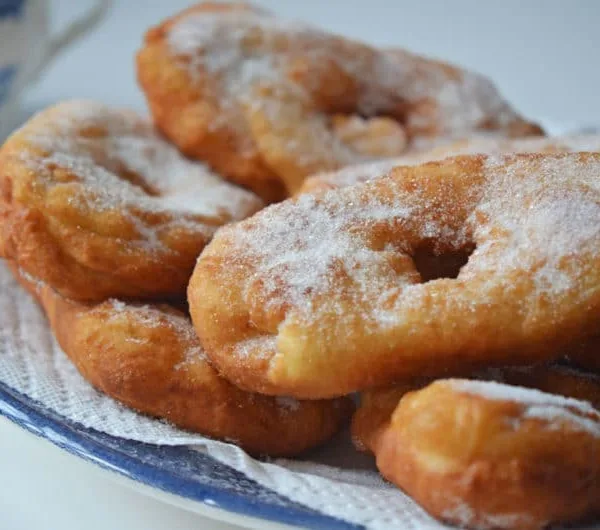







My “SIti” used to make what she just called Smeed (with the guttural language in there!) that as far as I know was just farina, milk and sugar then baked with dotted butter all over the top and then cinnamon. DO you know this recipe PLEASE? I have been trying to mimic it but without much success. Elise Maloof
How interesting–we also make “smeed” but it is a coarse bulgur pilaf and smeed refers to bulgur. Your smeed sounds just fabulous. I don’t know your specific recipe, I’m sorry!, but I’ll put that on my “to learn” list!
I have never seen the shredded dough..only in sheets. Suggestions? Cindy
Hi Cindy–knafeh/kataifeh is not typically in standard grocery stores, but is in Middle Eastern and other Mediterranean markets (frozen). You can also order it online on Amazon and elsewhere!
Is the farina the stuff we make basboussa with?
So i am confused, the the kounafa is on the bottom and the cheese on top when u babe and nothing on top? Just 2 layers? I use ricotta in my regular kounafa and it is like eshta heavealy. I will try ur recipe. Farmers cheese sounds delish too.
Hi Simone–yes, my recipe has one layer of the phyllo/knafeh and one layer of cheese. You turn the knafeh out afterwards and then the knafeh layer is on top. Give it a whirl! The farina is cream of wheat.
I make farmer’s cheese from a recipe on Allrecipes. That way I control the salt. I think I will try it in this recipe and report back.
Can’t wait to hear….
Hi Maureen I think I figured out what happened. My butter was still hot from melting it and once it got cooler the mixture turned out great. The knafeh was amazing and everyone enjoyed it. I will be making this time and time again.
Thank you for a perfect recipe !!
Oh wonderful news!!!!
I am making this now and got to the breadcrumbs and pastry part. I measured everything to a tea but it looks really wet.. not like your picture. Any suggestions to why this is and how to fix this next time ?
Hi Nat–hmmm, it’s hard to say without knowing exactly what you had in front of you. Was it wet even after baking?
Hello, Im gonna try this soon, but i live in egypt and I’m not sure if i will find Farina here, I’ve never seen it in the supermarkets here before. Is there anything that i can substitute it with?
Thanks
Yomna, look for Cream of Wheat cereal. You could also substitute polenta.
Lovely post about something near and dear! Knafe has always been a Tawil family favorite for breakfast. After my father found out he had celiac sprue, he devised an ingenious way to make knafe gluten free with cream of rice and then cheese and atar syrup as usual. So many ways to make knafe (and all of its cousins, like osmalleya) but always delicious any way you cut it! As always, your posts warm the heart.
Tania, thank you for that. I’m fascinated about your dad’s gluten-free knafeh! I’d love to know more about how he did it with the cream of rice.
best knefeh in lebanon kenit w ba3da 3and l bohsali (y)
Hello,I was wondering how can I make the syrup with less calorie for people following a diet on low sugar and low fat.
Thank you
want to make ahead several hours should I leave the Knafeh in its original pan and reheat or reheat on platter
I would reheat in its original pan, Joanne. Great question!
Dear Mauree,
Thank you so much for the great blog and the recipes. I have made few things from your recipes and all are working wonderful! I would like to add some pics from the Knafe I made today for the Palm day!
Best wishes,
Linda
I never heard of this until this week, my son sent me a recipe and said..make this! The recipe I have calls for ricotta, so that’s what I bought. I grew up with a Lebanese grandmother and don’t think I’ve ever had this. What do you think about the ricotta instead of Mozzarella ? It also said to use a “sweet cheese” That was Lebanese. Looked more like a solid cheese. Thank you.
Hi–thanks so much for this question. I think the mozzarella is the better way to go with the knafeh, as it creates a gooey chewiness that would be missing with ricotta. The Lebanese cheese used in knafeh is “ackawi” which is not as easy to find. It is very salty and would benefit from a little soak to remove some of the salt. But a totally salt-free cheese, which is traditional for this dish, is not as good in my opinion as having some salt to the cheese. Mozzarella works delightfully!
Thank you so much for sharing!!! I live in the SE Michigan area, and am fortunate to have middle eastern markets, bakeries, etc. all near me! I love the food, the culture, and most importantly–the people! Every time I visit Greenland Market, I end up chatting with fellow women about recipes.
Yesterday, I made my first stop at Lebon Sweets! I tried Knafeh, and was served it on a warm sesame-seed bowl-type piece of bread. It was unbelievable! It was quite filling, so next time I would have to split it with my husband or neighbors, as I could not eat the whole thing. I’m super excited to try your recipe, Maureen! Taste-wise, how would you say it compares to local Michigan-based middle eastern places? I’m curious to hear your input. I would love to hear any stories about your favorite Michigan Lebanese stores!
I can’t believe I found this recipe. I lived in Beirut for 3 years and later Jordan for 10 years and just loved Knafeh Looking forward to trying to make this
Thanks Maureen. BTW just bought your new cookbook. Really looking forward to using it! Was just given a collection of Mamoul molds and want to put them to use. Clare
Hi Maureen. I want to make this for a dinner party. Have you ever made and froze this dessert ahead of time? I live in Maine and bought the akwari cheese in Boston this week so I need to use it soon I think. I don’t know how long it can sit in my fridge. Dinner party is in 2 weeks. Any advice about the shelf life of the cheese and possibly freezing the dessert would be appreciated. Love your recipes. Half-Syrian Clare Hadea
Hello Half-Syrian Clare! The akawi cheese will last at least two weeks, and much longer, in the refrigerator. You will be fine to make this for your dinner party. Interesting question about freezing knafeh. I’m not sure how that would go for the texture, so best to bake it when you’re ready to serve it. Sounds like a great finish to your party!
Just came back from my first trip to Beirut and have been craving Knafeh ever since! Going to try to make it for my girlfriends this weekend. Thanks for the recipe.
It’s just so delicious! Hope you enjoyed every bite!
I was looking for a Middle Eastern dessert and our mutual friend Suzy (The Mediterranean Dish) sent me over to your blog. Love it.
Welcome! Wonderful!
Hi Maureen! When we visit my in-laws in Ottawa, there is always an early trip to the bakery to pick up kanafe. It’s our traditional farewell breakfast. Your recipe inspired me to surprise them when they were visiting U.S. since we have no place local to buy. I was all set to make this version but then I looked at your book and noticed the recipes were a bit different. I made the version in the book to rave reviews. Thank you!! I’m curious though as to why the recipes are different.
Hi there! Thanks for your comment! I published this recipe some time ago here on my blog, and then when I wrote my cookbook I redeveloped the recipe and tweaked it a bit. Both recipes are excellent, though! So glad you enjoyed it!
Hi Maureen,
I would love to try this recipe. Is there any way you could do a metric conversion? Also is there an alternative to farina? We don’t have farina in Australia.
Thanks.
Hi Alfred, instead of farina, we use in Australia Nurse’s Cornflour (yellow box) for the knafeh. You can find it at Coles or Woolworths. It is actually made of wheat starch. Interestingly this is what I found on the net: ‘Cornflour is the name given in Australia to the starch component of milled grains. Despite its name, it is often made from wheat. The whole ground grain is processed to remove most of the proteins (mainly gluten), leaving almost pure starch’. Happy baking…
How many ounces of fresh mozzarella are 2 cups? I’m having difficult understanding how fresh mozzarella can be measured in cups, and I’d love to make this recipe soon 🙂
Great question, thank you–that’s 16 ounces of mozzarella. I hope you do make it and love it as much as I do!
I have to tell u how much I’m enjoying your receipes and stories..my daughter margaret Anne went to school with u..keep em comin
Hello! Thanks so much, and warm regards to my classmate Margaret Curtain from Waverly (and you too!)!
Maureen, I love your pictures, writing, recipe… I had knaffe in Lebanon many times over the years and always ate it for breakfast. It was magical… there is no equivalent that Americans can relate it to, not really. This type of dish would be considered a dessert but is really perfect to consume first thing in the morning, with strong Turkish coffee or even tea… I believe this was my favorite culinary experience in Lebanon, and I’m not sure why, but maybe it is the perfect balance of sweet, cheese, crunchy, and hot… how I wish I could find some where I live now in San Francisco.
Thanks for your beautifully written article and for all the juicy details you provide about your journey through Lebanon, which really makes the mind picture everything, like a beautiful tasty movie experience!
Sarah
That’s beautiful Sarah, and you’ve put it so well, that this is perfect breakfast food! Thanks so very much.
I work in SF, Good Frikin Chicken on Mission St. sells good shawarmas and great knafeh! Hope you enjoy!
Great tip! Thanks very much!
Hi Maureen ,i’ve tried this recipe and i had good results .If you can help me with the recipe of the bread we eat kinafeh with I’ll be very gratefull .Cheers from Australia
Hi Saleem–I will work on that; I had it in Lebanon but have not made it at home (YET!).
Maureen this post makes me drool!! My late Mother in Law use to make this and I still remember the first time I tried it over 10 years ago now. The taste lingers on….
Great memory Lisa! Thanks for sharing!
it reminds me of a tour of all the knefeh eateries in my ‘hood, in beirut, with an iraqi friend until we finally landed at a good one in front of the sea next to the mosque; unfortunately now this place is gone and replaced by..Starbucks! \good news is `hallab has an outlet in Beirut and the knefeh is still the best. most home cooks here `i asked make it at home with kaak or breadcrumbs or buy the fark (semolina dough) from a pastry shop and the cheese already unsalted; i did it once. love your clics.
Thank you Joumana–how lucky you are to get Hallab whenever you want it!